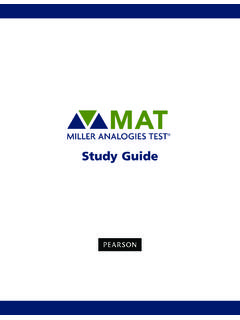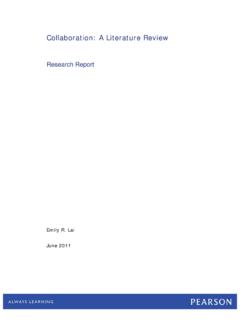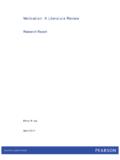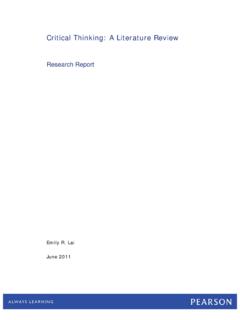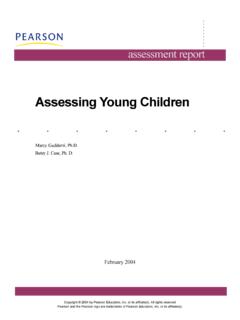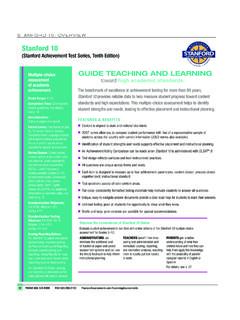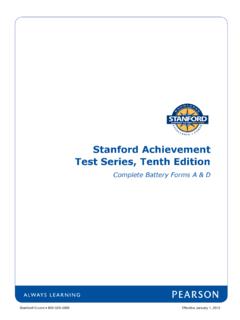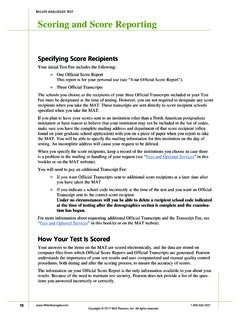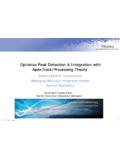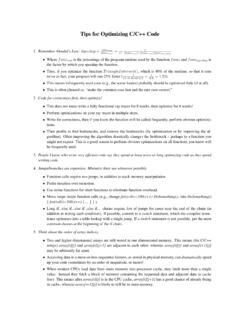Transcription of Assessing English Language Proficiency: Using Valid ...
1 Technical report Assessing English Language proficiency : Using Valid results to optimize Instruction Agnes Stephenson, , Psychometrician Diane F. Johnson, Senior Assessment Specialist Margaret A. Jorgensen, , Senior Vice President of Product Research and Innovation Michael J. Young, , Director of Psychometrics and Research Services Paper presented at the 81st Annual Meeting of the California Educational Research Association (CERA) November 14, 2003 (Revision 2, January 2004) Copyright 2003, 2004 Pearson Inc. All rights and the Pearson logo are trademarks of Pearson Education, Inc. or its affiliate(s)..TECHNICAL REPORT Assessing English Language proficiency : Using Valid results to optimize Instruction 2 Assessing English Language proficiency : Using Valid results to optimize Instruction Introduction The No Child Left Behind Act of 2001 (NCLB) has focused increased attention on the appropriate assessment of English Language learners (ELL students) in public schools.
2 NCLB specifically requires that English proficiency be assessed and that ELL students participate in a standards-based English Language testing program from day one. For the more than 4 million ELL students in K 12 public education across the United States, the federal expectation is that they will be able to function in regular classrooms within three years as proficient speakers, readers, and writers of English . There is much diversity among ELL students in public schools. Language , culture, and economic differences are evident, but also influencing students acquisition of English is their native Language literacy and education experience, motivation, and opportunity to learn, as well as the ability of teachers to meet the individual learning needs of these students. English Language proficiency measures must have a meaningful relationship with requirements of the classroom culture. From the perspective of testing, the challenges are to: understand the complexities of acquiring English Language proficiency ; determine how assessments can support effective teaching; build reliable and Valid assessments that are most likely to elicit critical evidence of English Language acquisition; document the psychometric properties of these items and tests; and validate proficiency so that there is a rational link between the English proficiency of ELL students and native English speakers.
3 The purpose of this report is to describe an assessment strategy that fulfills the requirements of NCLB and does so by supporting effective instruction for the complex population of ELL students in K 12 public schools. Copyright 2003, 2004 Pearson Inc. All rights and the Pearson logo are trademarks of Pearson Education, Inc. or its affiliate(s).. TECHNICAL REPORT Assessing English Language proficiency : Using Valid results to optimize Instruction 3 Understand the Complexities of Acquiring and Assessing English proficiency For teachers of ELL students in public schools, the goal of helping their students attain English Language proficiency is inherently complex. proficiency is often referred to as if it were a uniform state attainable by most students in a specifically defined time frame. This notion of a one-dimensional, global Language proficiency is, however, only a theoretical construct. Attaining Language proficiency is not a neat process Language skills (listening, speaking, reading, and writing) can be acquired at very different rates with spikes and plateaus during the learning.
4 So, when is a student considered proficient in English ? An ELL student does not need to be as fluent as a native speaker to be considered proficient. Rather, an ELL student needs to be proficient enough to participate in regular classes conducted in English without requiring significant English Language support. Furthermore, the proficient ELL student should have a good chance of success in those classes. During the Language acquisition process, immigrant children often achieve conversational fluency within one to two years, but their ability to reach grade-appropriate academic proficiency can take up to five years or longer. For these children, Language can generally be divided into social Language and academic Language . Jim Cummins (1979) identified this linguistic phenomenon as basic interpersonal communicative skills (BICS) and cognitive academic Language proficiency (CALP). The complementary relationship between academic and social English Language skills supports the structure of an English Language proficiency test called for in NCLB.
5 In general, the content areas of reading, writing conventions, and writing represent academic skills, and those of listening and speaking represent social skills. Accurately Assessing these two aspects of English Language skills, academic and social, provides a clear picture of a student s overall English proficiency . A student s level of Language proficiency is directly related to his or her success in regular classrooms. Determine How Assessments Can Support Effective Teaching English Language proficiency tests best serve the purposes of testing when they reflect both research and excellent teaching practices. Good testing and good teaching are grounded in research from the field of second Language acquisition. Decisions about test design test constructs and item constructs based on quantifiable evidence from current research yield stronger assessment instruments. At the same time, this research also provides a link between assessment and the thinking about what constitutes current best practices in instruction.
6 Copyright 2003, 2004 Pearson Inc. All rights and the Pearson logo are trademarks of Pearson Education, Inc. or its affiliate(s).. TECHNICAL REPORT Assessing English Language proficiency : Using Valid results to optimize Instruction 4 When experienced teachers of ELL students who are knowledgeable about the students and curriculum to be tested, provide the basic content for ELP tests, those tests are much more likely to be age-appropriate and in line with curriculum. So, teachers who have helped author English Language development standards are in the best position to know which standards are the most important ones to be tested, and these teachers are also the best people to furnish content for testing the standards. What Standards Represent English Language Acquisition? Most states are preparing or have completed content standards in English Language development. However, content standards published by Teachers of English to Speakers of Other Languages (TESOL) are commonly referred to as the national model for English Language acquisition.
7 The TESOL standards represent a widely accepted framework upon which many states are building their specific standards. The Stanford English Language proficiency Test (Stanford ELP), first published by Pearson in 2003, assesses students general acquisition of English by measuring: Listening, Writing Conventions, and Reading Using multiple-choice items; Writing, Using an open-ended direct writing assessment; and Speaking, Using a performance test. At the same time, state content standards are addressed by Stanford ELP. The development of Stanford ELP began with comprehensive reviews and careful analyses of current state and district English Language curricula and educational objectives. Pearson also reviewed current second Language acquisition research and considered the trends and directions established by national professional organizations. In order to meet the expectations of today s professionals and school officials responsible for teaching ELL students, Pearson took all the research into account when developing Stanford ELP.
8 Test blueprints based on Pearson s analyses address the Language skills to be assessed at each grade level. The blueprint for each Language skill outlines the topics to be covered, the instructional standards associated with each topic, and the proportion of test content to be devoted to each topic. After development of the Stanford ELP test blueprint, national experts reviewed it. These experts commented on all aspects of the blueprints: (1) the instructional objectives included at each test level, (2) the test level at which the objectives were introduced, and (3) the proportion of test content developed for each objective. The blueprints were then revised, and the final blueprints became the framework upon which the test forms were constructed. Copyright 2003, 2004 Pearson Inc. All rights and the Pearson logo are trademarks of Pearson Education, Inc. or its affiliate(s).. TECHNICAL REPORT Assessing English Language proficiency : Using Valid results to optimize Instruction 5 The final consideration in developing Stanford ELP was what specific Language should be tested.
9 Language , especially spoken Language , is fluid and ever-changing. It is essential that ELP tests focus on fresh, vibrant Language , the Language that is actually used in classrooms and the community. The goal must be to measure what matters to students to have teachers say, What I really like about this test is its ability to test Language that students really need. As shown in Table 1, the topics and vocabulary used in each of the four levels of the Stanford ELP are age-appropriate for the corresponding grade range. Table 1. Stanford ELP Test Levels and Corresponding Grade Ranges Stanford ELP Test Level Grade Range Primary K 2 Elementary 3 5 Middle Grades 6 8 High School 9 12 For each test level, particular care must be taken to ensure that both the Language proficiency and the chronological or developmental status of students are taken into consideration.
10 It is most important that all students are fully engaged in the content. To accomplish this, students interests must be addressed. Build Reliable and Valid Assessments that Measure English Acquisition Following the review of all the appropriate informational materials (publications of national professional organizations, district and state standards, and input from teachers and educators), Pearson developed a set of test specifications (blueprints) for Stanford ELP. The blueprints include the number of test levels necessary for complete coverage across all grades, the content areas to be assessed, and the instructional standards to be included in each content area. The blueprints specify the actual subtests to be included at each test level and the instructional standards to be assessed across the grade levels. The number of items that should assess each of the instructional standards to ensure breadth of content and reliability of assessment were also included in the blueprint.
